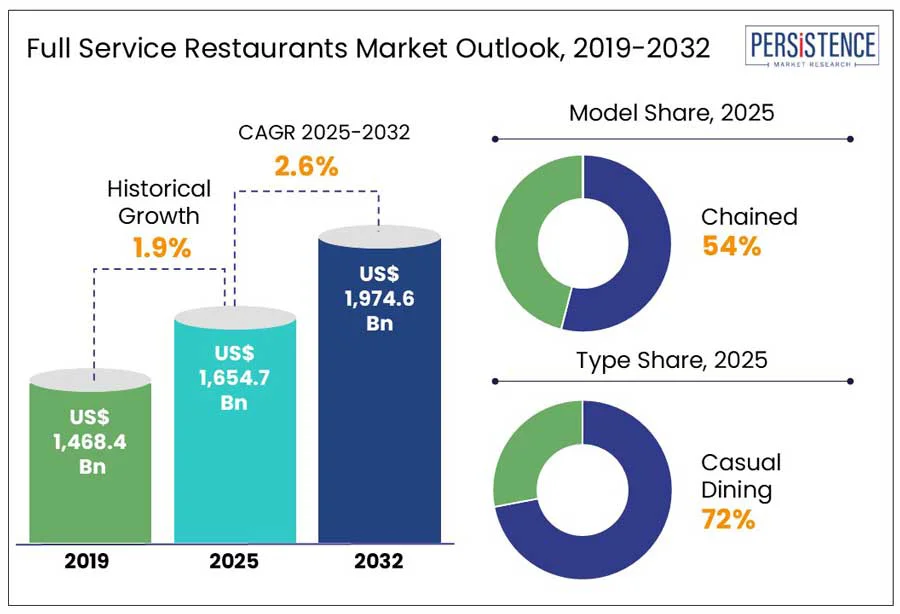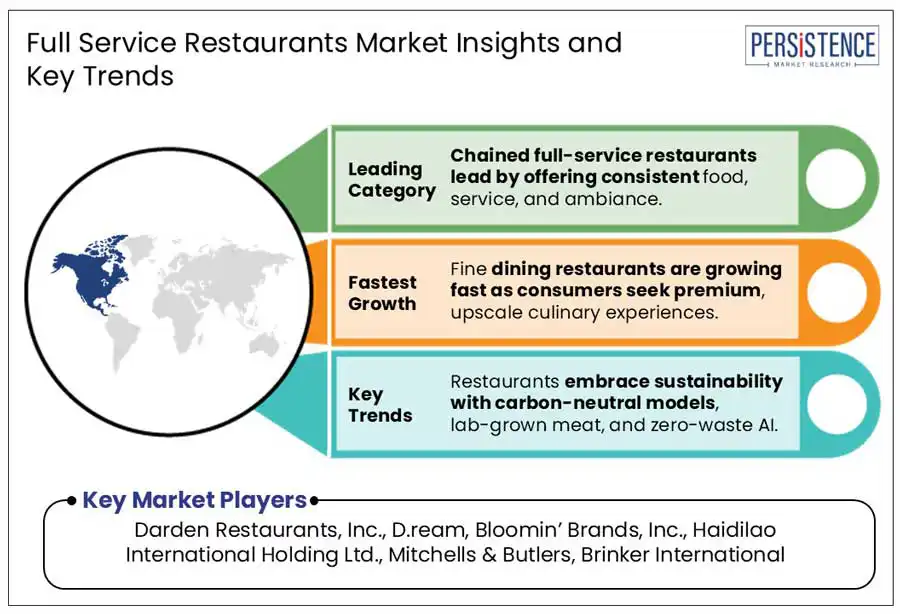ID: PMRREP30733| 190 Pages | 23 May 2025 | Format: PDF, Excel, PPT* | Food and Beverages

The global full service restaurants market size is estimated to grow from US$ 1,654.7 billion in 2025 to US$ 1,974.6 billion by 2032. The market is projected to record a CAGR of 2.6% during the forecast period from 2025 to 2032. According to Persistence Market Research report, the full-service restaurant market is poised for steady growth, driven by rising disposable incomes, experiential dining trends, and expanding urbanization. Emphasis on innovation, digital integration, and personalized offerings will be key to capturing future consumer demand across global markets.

Key Industry Highlights:
|
Global Market Attribute |
Key Insights |
|
Global Full Service Restaurants Market Size (2025E) |
US$ 1,654.7 Bn |
|
Market Value Forecast (2032F) |
US$ 1,974.6 Bn |
|
Projected Growth (CAGR 2025 to 2032) |
2.6% |
|
Historical Market Growth (CAGR 2019 to 2024) |
1.9% |
The demand for immersive and memorable dining experiences is increasingly shaping the global restaurant market. Consumers are seeking more than just a meal; they want an experience that engages their senses and offers unique moments. This has led to innovations in flush interiors, creative presentations, and live music that enhance the atmosphere and ambiance of dining spaces. Restaurants are incorporating mood lighting, thematic decor, and open kitchens to create a vibrant, dynamic environment. Additionally, creative food presentations that surprise and delight have become key to building memorable experiences. According to the National Restaurant Association, "9 in 10 adults say they enjoy going to restaurants. Restaurants allow them to enjoy a favorite meal that has flavor and taste sensations they can’t easily replicate at home." This underscores the growing importance of creating a multi-sensory dining experience that keeps customers coming back for more.
The job market has shifted significantly in the post-pandemic era, with a growing demand for remote or flexible roles. As a result, many workers are now looking for opportunities that provide better work-life balance, higher wages, and comprehensive benefits. In response, full-service restaurants are facing pressure to increase wages and improve benefits such as health insurance, paid time off, and mental wellness programs in order to attract and retain talent. Offering these benefits is no longer optional; it has become essential to remain competitive in a tight labor market.
However, the rising costs associated with these benefits are straining profitability and complicating hiring efforts. Therefore, restaurants are struggling to maintain consistent service quality and operational efficiency. Additionally, higher turnover rates lead to frequent recruitment cycles, which further impede long-term growth and customer satisfaction.
Automation and technology integration present a significant opportunity for restaurants to streamline operations and enhance the overall dining experience. Investments in advanced ordering systems, contactless payments, and delivery platforms have made it easier to provide faster, more convenient dine-in and off-premise options. Menu innovation combined with targeted digital advertising and loyalty programs allow restaurants to better engage with Generation X and Millennial families, who seek high-quality food, value, and meaningful connections with loved ones. The use of Augmented Reality (AR) and Virtual Reality (VR) further elevates the dining experience, offering interactive and immersive elements that captivate customers. Additionally, personalization engines enable restaurants to create tailored marketing campaigns and targeted discounts based on individual preferences, boosting customer loyalty. With these technologies in place, restaurants can improve operational efficiency, increase customer satisfaction, and ultimately drive profitability in a competitive market.
Chained full-service restaurants hold a 73% share of the global market due to their ability to maintain consistency across all locations. This uniformity in menu offerings ensures that customers know exactly what to expect, no matter where they dine. By standardizing service quality, chains can deliver a reliable and efficient dining experience, which builds customer trust and loyalty. The consistent atmosphere at each location also reinforces the brand identity, creating a familiar and comfortable environment for guests. This predictability is highly valued by customers, especially those who prioritize convenience and quality. For example, Compass Group, one of the world's leading providers of food services, operates in around 30 countries with 580,000 employees globally and generates revenues of $42 billion for the 2024 fiscal year. Their scale and consistency in service make them a key player in the global food service market, further highlighting the benefits of a chained model.
Independent model restaurants often offer unique, personalized dining experiences but face challenges in maintaining consistency and achieving economies of scale. These establishments also provide innovative menus or distinctive ambiance, appealing to niche markets, but they typically operate on a smaller scale and have limited resources for expansion or marketing.
Casual dining restaurants hold a staggering 72% market share in the Full-Service Restaurants Market due to their broader cuisine choices, diverse menus, and greater accessibility. These establishments cater to a wide range of tastes, offering everything from comfort food to international cuisine, making them appealing to diverse customer preferences. The flexibility in menu offerings, including healthier options, family-friendly dishes, and value meals, ensures that casual dining can satisfy a broad demographic, including families, young professionals, and budget-conscious consumers. Additionally, casual dining restaurants are more accessible, with relaxed atmospheres, affordable pricing, and multiple locations, allowing customers to dine out frequently without straining the budget.
However, fine dining restaurants often focus on specific culinary styles and high-end experiences, which tend to be expensive and reserved for special occasions. While they provide exceptional food and atmosphere, they serve a more niche market, limiting their reach compared to the versatility and accessibility of casual dining.

The North America Full Service Restaurants Market is expected to grow at a 2.5% CAGR during the forecast period 2025 to 2032. The industry is evolving amid shifting consumer behaviors, regulatory landscapes, and economic factors. Strategic partnerships with franchisees to expand into non-traditional venues like airports are enabling brands to access high-footfall locations and diversify revenue streams. Natural disasters, however, continue to pose operational risks, impacting traffic and supply chains. Regulatory pressures ranging from wage laws to menu labeling under the Affordable Care Act are increasing compliance costs.
Despite this, consumer spending remains strong; food accounts for 12.8% of U.S. household expenditures, with Canadians also poised to spend more due to recent tax rebates like the GST/HST relief. Additionally, rising demand for transparency, health-conscious menus, and digital ordering is shaping menus and service models. FSR operators that adapt through innovation, operational resilience, and value-driven offerings are best positioned to capitalize on evolving market dynamics in North America.
Europe Full Service Restaurants market is witnessing a strong recovery post-pandemic, driven by renewed consumer demand and tourism resurgence. Key markets such as the U.K., Germany, France, and Italy are experiencing growth in dine-in traffic, supported by easing restrictions and strong domestic and international travel. According to the World Travel & Tourism Council (WTTC), France is set to maintain its position as the world’s top destination for international arrivals in 2024, significantly boosting demand in its restaurant sector. In the U.K. and Germany, rising interest in experiential dining and regional cuisine is influencing menu innovation. Italy continues to benefit from its strong culinary heritage, attracting both locals and tourists. Digital transformation and sustainability practices are further shaping consumer expectations, making tech adoption and eco-conscious operations critical for long-term competitiveness across European markets.
Asia Pacific Full Service Restaurants market is undergoing rapid transformation, driven by shifting demographics, urbanisation, and technological adoption. In India, the restaurant industry is evolving with millennials over 35% of the population demanding affordable, healthy, and unique dining experiences. The rise of mobile apps, QR code menus, and online ordering platforms has redefined service delivery, especially in expanding tier-2 and tier-3 cities where disposable incomes are rising. Meanwhile, globalisation is enriching the region’s culinary diversity, catering to varied tastes and lifestyles. In China, although the full service restaurant sector was severely impacted by the COVID-19 pandemic, domestic demand is now a key growth focus as the government seeks to offset external economic pressures. Overall, the regional market is poised for dynamic growth, fueled by digital innovation, youthful consumers, and expanding middle-class appetites for diverse food experiences.
The global full-service restaurant market is highly competitive, shaped by evolving consumer expectations and continuous innovation. Businesses are aggressively pursuing both domestic and international expansion, often through strategic acquisitions to strengthen their market position and diversify offerings. Enhancing the dining experience remains a key focus, ranging from curated, customized menus that cater to dietary preferences and local tastes to lavish interior designs that create memorable atmospheres. Restaurants are increasingly located in exotic or high-footfall destinations to attract a broader clientele. The rise of celebrity chefs and signature dishes has added prestige and exclusivity, appealing to experience-driven diners. Meanwhile, high-end establishments leverage brand appeal through chef-led concepts and thematic cuisines.
The global full service restaurants market is projected to be valued at US$ 1,654.7 Bn in 2025.
Rising consumer demand for immersive and memorable dining experiences is Fueling Demand for the global full service restaurants market.
The Global Full Service Restaurants market is poised to witness a CAGR of 2.6% between 2025 and 2032.
Automation and Technology Integration to Streamline Operations and Enhance Dining Experiences are the key market opportunities.
Major players in the Global Full Service Restaurants market include Darden Restaurants, Inc., D.ream, Bloomin’ Brands, Inc., Haidilao International Holding Ltd., Mitchells & Butlers, Brinker Internationaland, and others.
|
Report Attributes |
Details |
|
Historical Data/Actuals |
2019 - 2024 |
|
Forecast Period |
2025 - 2032 |
|
Market Analysis |
Value: US$ Bn |
|
Geographical Coverage |
|
|
Segmental Coverage |
|
|
Competitive Analysis |
|
|
Report Highlights |
|
|
Customization and Pricing |
Available upon request |
By Model
By Type
By Cuisine
By Location
By Region
Delivery Timelines
For more information on this report and its delivery timelines please get in touch with our sales team.
About Author